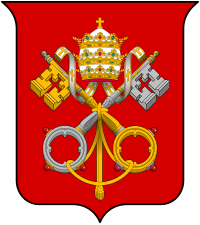Coat of Arms of the Holy See
| Coat of arms of Vatican City State | |
|---|---|
 |
|
| Details | |
| Adopted | 7 June 1929 |
| Escutcheon | The Fundamental Law of Vatican City State describes the shield as "Chiavi decussate sormontate del Triregno in campo rosso" (Keys in saltire surmounted by the papal tiara on a red field) and depicts the keys as two, one white (argent) in bend and one golden (or) in bend sinister, interlaced at their intersection with a red (gules) cord. The tiara is represented as white with golden crowns. |
| Coat of arms of the Holy See | |
|---|---|
 |
|
| Details | |
| Armiger | Holy See (former) |
| Adopted | late 14th century; use discontinued by mid-1980's; flags of Holy See and Vatican unified since then |
The coats of arms of the Holy See and Vatican City State in the form that combines two crossed keys and a tiara used as a coat of arms of the Holy See have origins attested from the 14th century. The combination of one gold and one silver key is somewhat later.
The coat of arms of Vatican City State, a sovereign entity established by the Lateran Treaty of 11 February 1929, was adopted by the Fundamental Law of the new state on 7 June 1929, and has its coat of arms defined by law as having the golden key in bend and the silver key in bend sinister.
For decades after the creation of the Vatican State, the arrangement of the keys in the Holy See's coat of arms as described in these sources distinguishes it from that of Vatican City State by a reversing of the gold and silver keys. However, such form of the coat of arms has no longer been used by the Holy See for decades: in all official events and including in the diplomatic missions of the Holy See abroad, it is always the regular Vatican City flag, with the golden key pointing upwards to the right (and the silver key pointing upwards to the left), that is flown, and the Vatican now only uses the Holy See coat of arms in monochrome, which renders it in practice one and the same as the coat of arms of the coat of arms of the Vatican City.
Ecclesiastical heraldry had the same origin and developed contemporaneously with general heraldry, which had become general throughout England, France, Italy and Germany by the end of the 12th century. Ecclesiastical heraldry appears first in seals, nearly all vesica-shaped.
The earliest blazoning of the arms of the Holy See is that found in Froissart's Chronicles of 1353, which describes them as "gules two keys in saltire argent". From the beginning of the 14th century, the arms of the Holy See had shown this arrangement of two crossed keys, most often with a gold key in bend and a silver in sinister but sometimes with both keys gold or, less often, both keys silver, as described by Froissart.
The practice by which the gold key is placed in bend and the silver in bend sinister, was slow in establishing itself, and only from the time of Pope Pius II is it found with certainty. "The practice of placing a gold key in bend over another in bend sinister of silver is not found with any certainty before the time of Pius II (1458-64)."
...
Wikipedia
